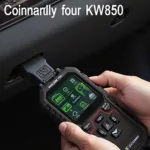Finding an “HDMI to OBD2” adapter at Lowes might seem like a logical step if you’re looking to connect your car’s diagnostic port to a display. However, this search is based on a misunderstanding of how these technologies work. While you won’t find an HDMI to OBD2 adapter at Lowes, or anywhere else for that matter, this search provides an excellent opportunity to explore the world of OBD2 scanners and how they can help you understand and maintain your vehicle.
Understanding the HDMI and OBD2 Disconnect
The confusion arises from the desire to view diagnostic data on a larger screen. HDMI (High-Definition Multimedia Interface) is designed for transmitting high-definition audio and video signals, typically between devices like computers, gaming consoles, and televisions. OBD2 (On-Board Diagnostics II), on the other hand, is a standardized system for accessing vehicle diagnostic information. They use entirely different protocols and connectors. Thinking of them as compatible is like trying to fit a square peg into a round hole. An HDMI port expects digital audio and video signals, while an OBD2 port provides access to vehicle data using a specific communication protocol. There’s no bridging the gap with a simple adapter.
What are you actually looking for?
If you’re searching for “HDMI to OBD2 at Lowes,” you’re likely looking for a way to view your car’s diagnostic data on a larger screen. While a direct HDMI connection isn’t possible, several OBD2 scanners offer alternative solutions, like connecting to a laptop or smartphone via Bluetooth or Wi-Fi. These devices can then display the data on their larger screens, providing a more comfortable viewing experience.
Exploring the World of OBD2 Scanners
OBD2 scanners are invaluable tools for car owners and professionals alike. They range from basic code readers to sophisticated diagnostic platforms, offering a range of features and price points. Basic scanners can retrieve and clear diagnostic trouble codes (DTCs), giving you a starting point for troubleshooting car problems. More advanced scanners can access live data streams, perform actuator tests, and even program certain vehicle modules.
Choosing the Right OBD2 Scanner
Selecting the right OBD2 scanner depends on your needs and budget. A basic code reader might be sufficient for the average car owner who wants to check engine codes and monitor a few basic parameters. Professional mechanics, on the other hand, require more advanced scanners with extensive diagnostic capabilities.
Using an OBD2 Scanner
Using an OBD2 scanner is generally straightforward. Locate your vehicle’s OBD2 port, typically under the dashboard on the driver’s side. Plug the scanner into the port and turn on the ignition. The scanner will then communicate with your vehicle’s onboard computer and retrieve diagnostic information.
Interpreting OBD2 Data
While retrieving codes is simple, interpreting them can be more challenging. Each code corresponds to a specific fault or condition. You can use online resources or repair manuals to decipher the meaning of each code and determine the appropriate course of action.
“Understanding OBD2 data empowers car owners to take control of their vehicle’s maintenance and repairs,” says Robert Johnson, Senior Automotive Diagnostic Technician at Johnson Automotive. “It can save you time and money by helping you diagnose problems early and avoid unnecessary trips to the mechanic.”
Conclusion
While you won’t find an “HDMI to OBD2” adapter at Lowes, understanding the purpose of your search opens up a world of possibilities with OBD2 scanners. These powerful tools empower car owners and professionals to diagnose and address vehicle issues efficiently. By selecting the right scanner and learning to interpret the data, you can take control of your car’s health and avoid costly repairs.
FAQ
-
What is an OBD2 port? The OBD2 port is a standardized connector that provides access to a vehicle’s diagnostic information.
-
Can I use any OBD2 scanner on my car? Most modern cars use the OBD2 standard, but it’s always best to check your vehicle’s compatibility.
-
Where can I buy an OBD2 scanner? OBD2 scanners are available at auto parts stores, online retailers, and even some electronics stores.
-
How do I know if my car is OBD2 compliant? Check your owner’s manual or look for a label under the hood or dashboard.
-
What are diagnostic trouble codes (DTCs)? DTCs are codes that indicate specific faults or conditions within your vehicle’s systems.
-
Do I need a professional to use an OBD2 scanner? Basic scanners are user-friendly, but interpreting the data might require some research.
-
Can an OBD2 scanner fix my car? An OBD2 scanner only diagnoses problems; it doesn’t perform repairs.
“Investing in a quality OBD2 scanner is like having a personal mechanic in your pocket,” adds Maria Sanchez, Lead Technician at Sanchez Auto Repair. “It’s an invaluable tool for any car enthusiast.”
Need help? Contact us via WhatsApp: +1(641)206-8880, Email: [email protected] or visit us at 789 Elm Street, San Francisco, CA 94102, USA. We offer 24/7 customer support.


